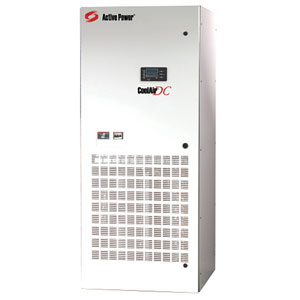New products
New product and service offerings from company press releases
Laser-based moisture analyzer
Fast and more dependable than conventional gas sensors, laser-based analyzers from SpectraSensors facilitate optimization of gas production, eliminating maintenance, replacement and manpower costs. With offshore platforms pumping 1 MMcfgd-plus, the efficient receiving and distribution of onshore receiving facilities (ORF) depends on continuous and accurate moisture analyzer readings. Sensor dependability can have an impact on gas production volume, because if a sensor is inaccurate or out of service, the ORF will likely slow down the flow to a level where the moisture content was determined satisfactorily on a historical basis. Because of its design and sampling methodology, a laser-based moisture analyzer can be operated for years without maintenance. SpectraSensors utilizes ultra-precise �tunable diode� laser spectroscopy (TDLS), and performs measurements in a �sample cell.� Because they are not exposed to corrosive contaminants, the analyzers maximize dependability and minimize cost of ownership.
New software version improves expandability OpenSpirit has made design change to its application and data integration software to enable rapid expansion of the geotechnical data footprint. Version 3.0 will give geoscientists and data managers faster access to the additional data types, domains and data stores that are integral to the E&P decision-making process. This significant redesign provides an easier, more streamlined installation, a more intuitive user interface, enhanced deployment flexibility and easier use among OpenSpirit-enabled applications. The data footprint extensibility will accommodate a series of future releases that will include new and enhanced data types, expanded domains and new data connectors. The infrastructure will allow faster rollout of this functionality for the years to come. New features include: installation that no longer requires Oracle, reducing installation complexity and ongoing maintenance; a Windows master installation option to offer more flexible deployment options; new coordinate service based on the EPSG database and ESRI Projection Engine; and new administration tools. Performance efficiency is improved by combining OpenWorks and SeisWorks data connectors, and by combining GeoFrame and Charisma/IESX data connectors.
Pump modeling software Pump Systems Matter, a non-profit educational association, has made Pump Systems Improvement Modeling Tool (PSIM) educational software freely available for download on its website, www.PumpSystemsMatter.org. PSIM is focused on helping pump system engineers and industry professionals understand how modeling tools can reduce cost and conserve energy. The PSIM tool operates by allowing users to build models of pumping systems. The software then uses input from various fields to simulate a wide range of system behavior. Users can calculate pressure drop and flow distribution in straight-path and simple branching or looped pumping systems, as well as pump energy usage and energy cost over time through Net Present Value concepts. PSIM also models pump vs. system curves, pump efficiency and best efficiency point (BEP), NPSH calculations, impeller trimming, and automatic pump curve viscosity corrections.
Shock tools Stabil Drill, a Superior Energy Services company, has introduced a new line of shock tools, designed to provide an improved rate of penetration and minimize axial vibrations during drilling operations. The tools absorb shock load on the drill string and drill bit. These tools are oil-lubricated and sealed for a longer operational life. The tools also reduce vibrations, utilizing a series of springs, light, medium or heavyweight to accommodate various drilling conditions. Designed to enhance the company's roller reamer line of products, the tools are available in sizes ranging from 43/4 to 91/2 in. and can operate in temperatures of 275�450°F, depending on the seal.
Ultrasonic transducer
Dynasonics DTTS transducer series is designed to provide easy, low-cost installation on pipe and rigid tubing sizes from 1/2-in. (12mm) to 2-in. (50mm). When matched with any Dynasonics Transit Time transmitter, it can replace mechanical flow meters in applications, where liquid conditions tend to damage or impede mechanical flow meter operation. The transducer does not contact the internal liquid, and has no moving parts. Because it clamps onto the outside of existing piping and tubing, there is no process shutdown, and solids pass through the pipe with no effect on the transducer. The DTTS is suitable for most clean liquids or liquids containing small amounts of suspended solids or aeration, and can be used on carbon steel, stainless steel, copper and plastic pipe materials. The transit time flow meter product line includes the TFXL integral or remote mount; TFXD dedicated meter; the portable TFXP; and the TFXM multiple pipe, multiple path meter.
Photoacoustic infrared gas monitor
The MSA Chemgard Gas Monitor uses photoacoustic infrared sensing technology to detect a large number of industrial gases down to low ppm or percent levels. A variety of output ranges are available, and the monitor comes in three versions: explosion-proof, NEMA 4 and rack-mount. Options include heated and/or Z-purged enclosure, built-in auxiliary gas sensor, remote relay module and remote display. The unit can be configured to monitor from up to eight remote areas. Standard features include vacuum fluorescent display, audio alarm, four relays and 4-20mA and 0-10V outputs.
High gas capacity filter separators
UPS with backup cooling
CoolAir DC from Active Power, based on the company's Thermal & Compressed Air Energy Storage (TACAS) technology, provides an extended-runtime, battery-free, energy storage solution for 3-phase uninterruptible power supply (UPS) applications. It represents a minute-for-minute alternative to lead-acid batteries for all critical operations, without the inherent problems typically associated with batteries. Additionally the unit provides backup cooling during discharge. Features include extended backup time, with highly accurate runtime and consistent performance; a 20-year lifespan; low maintenance; self-diagnostic capabilities with local and remote monitoring; 0�40°C operating temperature; adjustable output voltage; and a small raised floor footprint. Cooling during discharge allows the critical loads to run for a longer duration in the event of an extended power outage, especially at sites where the possibility of having a standby generator to keep the cooling system in continuous operation is impractical.
Book Review By Prof. James F. Lea, Henry V. Nickens, and Mike R. Wells, Gulf Professional Publishing, 2003 As gas wells deplete, the velocity in the tubing drops, and eventually liquids from the well and condensation begin to accumulate in the tubing. This adds back pressure on the formation, which reduces or stops flow. There are about 400,000 gas wells in the US, and most are liquid loaded. Solving this problem may increase production an average 40% per well. Gas Well Deliquification by Professor James F. Lea, et al., introduces the subject of liquid loading problems and discusses how to distinguish them from other possible well problems. The book covers the methods of solving the problems, how to apply the various solutions, and the advantages and disadvantages of each. It describes various methods of de-watering gas wells, comparing them and explaining the suitability of each under particular circumstances. The material is presented as practical information that can be immediately applied, rather than simply theory. Useful historical methods are described, but the focus is on the latest techniques. Solutions range from simple application of smaller ID tubing to complex artificial-lift methods. Gas Well Deliquification is composed of 14 chapters and three appendixes. Subjects covered are: • Symptoms that a gas well has liquid loading problems, with emphasis on symptoms that are typical to most fields. • The critical velocity method of predicting liquid loading, along with nodal analysis techniques. • Basic concepts of tubing design to prevent excessive friction and keep velocity high enough to avoid liquid loading. • Compression to help increase gas velocity to equal or exceed the critical unloading velocity. Methods to estimate the impact of compression on production rate are also presented. • Various methods of artificial lift such as plunger lift, beam pumping, electrical submersible pump (ESP) for gas reservoirs that produce high volumes of liquid, progressing-cavity pumping (PCP), and continuous and intermittent gas lift. • Foam to de-liquefy gas wells. • Hydraulic powered downhole pump fundamentals, including advantages and disadvantages, system comparative costs, and case histories. • Methods to eliminate or reduce gas interference. New downhole pumps designed to be operable in the presence of gas interference or gas locking are discussed. Other, more non-conventional methods are presented, such as wellbore insulation, downhole heating using a resistance cable to keep more liquid in the vapor phase, surface jet pumps or eductors to lower wellhead pressure, novel downhole inserts to modify the flow pattern, well cycling, tubing flow controllers and other techniques. Overall, Gas Well Deliquification serves as a primer to most of the frequently used methods that can help gas well production when liquids become a problem. It is operator-oriented and presents methods to recognize and model liquid loading. It provides information that is useful to both new and experienced engineers and is a practical tool for every engineer, scientist, and researcher who has ever faced the challenge of gas well production and optimization. |
||||||||||||||||||||||||||
- Applying ultra-deep LWD resistivity technology successfully in a SAGD operation (May 2019)
- Adoption of wireless intelligent completions advances (May 2019)
- Majors double down as takeaway crunch eases (April 2019)
- What’s new in well logging and formation evaluation (April 2019)
- Qualification of a 20,000-psi subsea BOP: A collaborative approach (February 2019)
- ConocoPhillips’ Greg Leveille sees rapid trajectory of technical advancement continuing (February 2019)


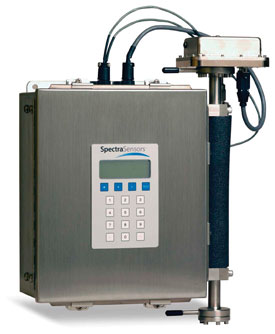
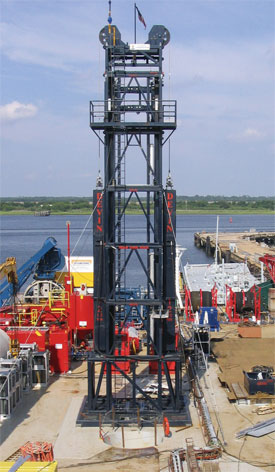
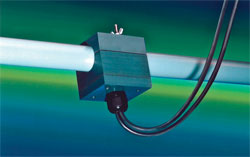
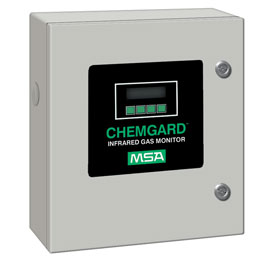
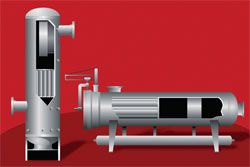 For gas plants, gathering systems and other applications, AMISTCO horizontal double-barrel and/or vertical filter separators provide efficient solid and liquid removal in applications with high gas capacities. The compact two-phase design of these systems and minimal maintenance requirements make them suitable for offshore and other space-tight applications with high gas flowrates. The systems can also serve to debottleneck existing on- and offshore processes with a relatively small footprint. The coalescing filter element design removes the bulk liquid and solid particles and then coalesces the fine liquid droplets into larger ones, which are removed in the second-stage double pocket vane. The double pocket vane, though very efficient, is highly resistant to plugging. Coalescing filters can be replaced periodically, or designs can be manufactured which can be cleaned and reused.
For gas plants, gathering systems and other applications, AMISTCO horizontal double-barrel and/or vertical filter separators provide efficient solid and liquid removal in applications with high gas capacities. The compact two-phase design of these systems and minimal maintenance requirements make them suitable for offshore and other space-tight applications with high gas flowrates. The systems can also serve to debottleneck existing on- and offshore processes with a relatively small footprint. The coalescing filter element design removes the bulk liquid and solid particles and then coalesces the fine liquid droplets into larger ones, which are removed in the second-stage double pocket vane. The double pocket vane, though very efficient, is highly resistant to plugging. Coalescing filters can be replaced periodically, or designs can be manufactured which can be cleaned and reused.